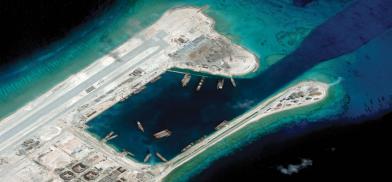A regional bulwark a must to contain China's designs in South China Sea
In fact, China’s rising imperialist aggressions and assertions over the South China Sea, followed by China-India standoff, have prompted the US to display its awe-inspiring military power in the disputed waters of this region

In fact, China’s rising imperialist aggressions and assertions over the South China Sea, followed by China-India standoff, have prompted the US to display its awe-inspiring military power in the disputed waters of this region. This is so with a view to deterring Beijing’s increasing transgressions with the mightier power of America. Indeed, the US wants to maintain and assert its unquestioned global hegemony in Indo-Pacific but that has been under serious threat due to Beijing’s rising expansionism in the entire Indo-Pacific. China has been vigorously pursuing its expansionist policies - from the Indian Ocean to the African continent - for the past many years, thereby, leading to undesired border disputes with almost all countries in this region. Surprisingly, China has not spared even major powers like Japan or Russia with a view to satisfying its unlimited greed for capturing islands or lands of other countries.
Thus, China’s outrageous and hostile behaviour with most of the countries has obviously led to forging of a global consensus among almost all major and regional powers including smaller ones in the Indo-Pacific. Further, with China being seen as the origin for coronavirus has already united the international community and these countries want Beijing to be taught a lesson to contain its aggressive misadventures.
Here an obvious question arises - whether or not - this kind of intervention by a faraway superpower in Asian affairs are appropriate? Particularly when America has not been mandated by the Security Council or General Assembly of the United Nations to take any action against China. Nonetheless, the US is earnestly pursuing a bigger and more threatening military exercise against Beijing’s ongoing military exercise in the disputed waters of the South China Sea, thereby arousing a grim scenario for the entire region. This is why the ongoing row between the US and China over the South China Sea is becoming bad to worse with both sides hectically engaged in massive showoff of their respective dreaded weapons.
While China has threatened to use DF-21D and DF-26 missiles to destroy the two American aircraft carriers viz, USS Nimitz and USS Ronald Reagan already deployed in the region, Washington has responded with greater firmness to reciprocate a massive retaliation to any misadventure undertaken by China. Further, Beijing is deploying J-12 fighter Jets whereas Washington is sending its Naval Strike Groups to the South China Sea. Thus, the mounting belligerence between the two with each passing day evidently poses ominous portents for peace and security of not only the two opponents but for the whole world. It is clear that both the US and China are today mighty military powers and are equipped with nuclear weapons and many other advanced lethal arsenals.
While the US is still having the exceptionally largest pool of such deadly weapons and highly trained military personnel that turn it to be the strongest global military power, China is keeping the largest army with a huge accumulation of various modern and dangerous armaments. Indeed, the superior and advanced technical features of the US military can change the territorial status quo in the South China Sea though that may result in a third World War.
But that must not happen as war is not a solution to any crisis. Instead, peaceful and diplomatic solutions may be pursued to resolve this China-US faceoff over the South China Sea. The US has justified its ongoing military exercises for resisting China’s illegal sovereign claim over the entire South China Sea and for ensuring unhindered navigation through maritime channels, China persists with its military exercise to protect its territorial claims over islands, despite losing the case in the International Court of Arbitration in 2016. Not only that, but Beijing also obstructs the free movement of naval cargoes of other countries passing through this region, reiterating its false claim. Instead of obeying the judgment of the world’s apex court, China has turned the entire region into a fortified zone stationing its army and arsenals. Also, being the sole superpower in the world, America carries its responsibility to promote international trade and commerce through this region too. Similarly, China is also expected to honour and share the accompanying responsibility that follows with its rising power status in the world.
In this scenario, doesn’t it show a collective failure of all Asian powers which are unable to tame the increasing militarist expansionism of China! Haven’t they failed to evolve a common united front to pressurize Beijing to respect the territorial sanctity of all other nations? Though there is no other option but to tame the dragon by force, this kind of power game by an external sole superpower is not good for the cohesiveness of Asia. This may open door to greater mutual bickering among regional partners as seen in West Asia which still continues to be a boiling pot due to the continuing superpower rivalry therein. World history is replete with many instances of superpowers involvement in different regions in the world, which afterward suffered much violence and insecurity.
Thus the legal sanctity of the South China Sea as pronounced by the apex court must be restored and any intervention by external powers is discouraged. This would mean increasing cooperation among the regional member states which must evolve a powerful regional bulwark to contain the bullying and hegemonic-aggressive policies of China.
Beijing must respect the territorial sanctity of all other sovereign states in accordance with the spirit of Panchsheel. Or it may have to face collective international wrath united under US leadership.
(The writer is Professor of Political Science at Rajarshi Tandon Open University, Prayagraj, Uttar Pradesh. The views expressed are personal)










Post a Comment